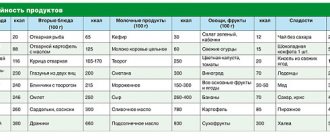Dancing for weight loss: how many calories can you burn in a workout?
Psychologists consider dancing one of the best methods for weight loss!
Everything is simple here: more activity means more calories burned, and as a bonus, a lot of positive emotions. A positive attitude in the process of losing weight is very important.
And so, our selection of the 10 most popular dance styles: 1)
Ballet - 700-750 kcal/hour During a workout, performing classical steps, you can burn about 750 kcal.
And in order to look graceful, the trainer will also recommend reducing your daily caloric intake to a minimum. 2) Hip-Hop - up to 750 kcal/hour The main elements and techniques of this style are: “swinging” the body, jumping, falling, spinning and light acrobatic movements.
3) Reggaeton - up to 700 kcal/hour Sudden movements involve all muscles, high-quality cardio exercise strengthens the heart muscle and “accelerates” the blood. During the dance, the legs, hips and buttocks are strengthened, giving the shape a piquant roundness;
4) Modern jazz - up to 650 kcal/hour This “mixture” of elements of classical ballet, ballroom dancing, tap, break and other styles is attractive because it heavily loads almost all muscle groups, and this is extremely important in the process of losing weight;
5) Zumba - 525 kcal/hour Zumba is a dance fitness program that combines fitness exercises and movements from Latin American dances.
6) Floor dance (strip plastic) 500 kcal/hour It combines cardio exercise, stretching exercises and at the same time strength training. Almost all muscle groups are involved. The main load falls on the legs, stomach, back and buttocks.
7) Twerk - 500 kcal/hour Twerk is a very erotic dance, the roots of which can be found in American southern rap. Dance actively works the legs and hips, and also increases the density of the pelvic bone tissue, which helps to avoid osteoporosis.
 Latin - 450-500 kcal/hour Latin is a common name for many types of Latin American dances, such as mamba, bachata, jive, rumba, cha-cha-cha and others. What they all have in common is that the dance is based on energetic movements that actively help fight excess weight.
Latin - 450-500 kcal/hour Latin is a common name for many types of Latin American dances, such as mamba, bachata, jive, rumba, cha-cha-cha and others. What they all have in common is that the dance is based on energetic movements that actively help fight excess weight.
9) Belly dancing or oriental dancing - 300-400 kcal/hour Perhaps this is the most feminine dance of all possible fitness areas and, at the same time, the simplest in terms of choreography. The benefits of oriental dancing are difficult to overestimate, especially for women: when belly dancing, you actively shake your hips, as a result of which blood circulation increases in the pelvic organs. This helps restore ovarian function and also has a beneficial effect on the uterine lining. With the help of oriental dance, cramps during the menstrual cycle are reduced.
10) Contemporary - up to 400 kcal/hour Contemporary is a dance style consisting of many different techniques and styles. It is based on classical dance, modern and oriental techniques - qigong, yoga, taijiquan.
As you can see, dancing is a great helper in the process of losing weight. The main thing to remember is that it is important not only to lose, but also to maintain weight. An important factor that helps not to gain extra pounds is a fast metabolism, which can only be achieved with the help of strength training. Dancing is, first and foremost, a cardio workout. Therefore, do not forget to add strength exercises 2-3 times a week to achieve truly high-quality results!
Types of exercises
To understand what stretching in fitness is, you need to understand its types. According to the method of performing stretching, they are classified into:
- static,
- proprioceptive neuromuscular,
- ballistic,
- dynamic,
- isometric,
- active.
The following types of stretches are useful in their own way.
When performing them, it is important to adhere to the principle of gradually increasing the complexity of the exercises.
Static stretching
The most effective, injury-free exercise option. Therefore, it is most suitable for beginners. Its essence is that a person freezes in a motionless position for 30-60 seconds while performing the exercise. Muscles in this state remain tense
To achieve the effect, you need to completely focus your attention on the muscles: you need to feel how they stretch. But don't feel too much pain
There should be a gentle effect on the tendons and joints: stretching occurs due to its own weight.
Flexible body, graceful movements and plasticity - isn’t this beauty?
Proprioceptive
Proprioceptive neuromuscular stretching is used for therapeutic purposes to restore joint function after injury or surgery. Such exercises should only be performed under the supervision of an experienced instructor. The system combines two types of exercises at once - passive and isometric, when the muscles contract. In one technique, the muscles are first slowly stretched, then contracted under the influence of external resistance, then they relax and stretch again. According to the second method, the main muscle first relaxes, then the opposing muscle contracts. After this, the main muscle contracts.
Ballistic stretch
Ballistic stretching can only be used by trained athletes. How to do exercises correctly? They are done sharply with increasing amplitude. Let's demonstrate this type of stretching on slopes with arms extended towards the toes. During normal bending, it is difficult for a person with poor stretching to bend toward the feet without bending the knees. A trained athlete with ballistic stretching will be able to make sharp bends in a standing position without bending his legs. Thanks to such sudden movements, the muscles instantly react, increasing in length.
You can stretch muscles and tendons using various exercise techniques.
Dynamic
This stretching can be done by untrained people. It consists of controlled movements of the upper and lower extremities: rolls, swings. These can be both fast and slow movements. In this case, alternating muscle tension and relaxation occurs.
Benefits of dancing
It just seems that the load is not enough to seriously lose weight. In fact, this activity is right in the fat-burning cardio zone (60-80% of your maximum heart rate), so you are actually dancing and losing weight. However, it is worth remembering that the number of calories burned depends on your age, weight and metabolic rate. Therefore, you should not compare yourself with someone else.
Another plus is that the whole body works during the training process. This is why dancers have such beautiful and strong bodies with proportionally developed muscles (virtually no distortions).
Other benefits: improves coordination, increases flexibility and self-confidence, strengthens bones, prevents osteoporosis, has a positive effect on the functioning of the cardiovascular and respiratory systems, develops a sense of balance and a sense of self in space, teaches communication.
How many calories do different types of dancing burn per hour?
So, you decided to take up dancing and lose weight at the same time. Each type of this activity has its own intensity, and the numbers for each workout will be different. Do not forget that in addition to intensity, physiological factors influence the number of calories.
- Zumba: from 350 to 650 kcal.
- Folk dances (depending on intensity): slow tempo - from 250 to 330 kcal, fast tempo - from 310 to 420 kcal.
- Pole dancing (half dance): from 250 to 350 kcal.
- Break dancing: from 400 to 650 kcal.
- Tap dancing: from 200 to 700 kcal depending on the intensity and number of steps.
- Belly dancing: from 270 to 320 kcal.
- Ballet: from 380 to 450 kcal.
- Hip-hop: from 370 to 610 kcal.
- Salsa: from 405 to 480 kcal.
- Swing: from 300 to 550 kcal.
- Samba: up to 400 kcal.
- Jive: from 300 kcal to 400 kcal.
- Cha-cha: up to 440 kcal.
- Jazz: from 334 to 534 kcal.
- Tango: about 240 kcal.
- Flamenco: from 225 to 350 kcal.
- Ballroom dancing competition: up to 755 kcal.
If you are interested in more accurate data for your weight, there is a wonderful online dance calorie calculator!
Sections on the topic of diets:
| • Fat burner • Diet 25 frames • Kremlin diet • Brazilian diet • Buckwheat diet • Kefir diet • Pineapple diet • Dukan diet • For pregnant women • Horoscope diet • Blood type diet • Weight loss conspiracy • How to lose weight in a week • How to get rid of unpleasant smells | • Lose 10 kg • Day diet • Vegetable diet • Fruit diet • Charcoal diet • Ginger diet • Lose weight in 3 days • Drinking diet • Oatmeal diet • Grapefruit diet • Low-carbohydrate diet • Koroleva diet • Pugacheva diet • Larisa Dolina diet |
See also: Calorie table for Ready Meals
How many calories can you burn in a nightclub?
It’s unlikely that anyone would think of taking a cardio sensor and a fitness gadget for counting calories with them to a disco in a nightclub. But you can at least estimate exactly how many calories you will burn in the evening. Research conducted at Harvard Medical School will help us with this. If you weigh about 57 kg, you will burn approximately 5.5 kcal in one minute of moderate intensity dancing. 330 kcal accumulates in an hour. If you weigh 70 kg, during the same time you will burn 410 kcal (almost 7 kcal per minute), and if you weigh 84 kg, the amount of energy burned will be 488 kcal (about 8 kcal per minute).
What conclusions does this lead to?
1. You need to lose weight not only by training, but also by regulating your diet. And often this even outweighs in its importance and effect fitness classes. But still, nutrition works much better in conjunction with fitness.
2. Don't give up training. They are very important because they speed up metabolism and increase muscle size. And one kg of muscle, as is known, even in a passive state burns about 50 kcal. This is just a gift for someone who wants to lose weight.
3. Your client should be mentally prepared for long-term work. For about a year. Take care of this. Otherwise, she risks becoming disillusioned with fitness. Then the result will be significant and irreversible, since during this time she will be able to properly learn to take care of herself in terms of nutrition and physical activity.
And finally, a quote from one reader of the site. “Calorie burning is very closely related to the time of year. I think for women who want to lose weight, this should be taken into account. In winter, the body tends to “warm itself” and it reluctantly gives up accumulations in the form of fat, and every indulgence in nutrition and self-pity is deposited in the form of hated folds.
Victory over excess weight depends on many factors: mood, state of health, what you ate last night, what thoughts you came to the gym with, your mood for training, etc.
Cardio machines have a function that shows the calories you've probably burned. BUT! this is not a dogma, that the numbers on the simulator panel are dogma and you can calm down with relief after leaving the gym with a feeling of accomplishment. No.
If after training, along with pleasant fatigue, there is no elation and good mood, you have simply exhausted your body, and it will greedily seek replenishment with energy: lie down, sleep, eat, sit, feel sorry for yourself after physical torment. The golden rule of weight loss is to come to the gym not with self-hatred, but with love, and leave even more loving and respecting yourself.”
Dancing as therapy
In addition, dancing works great as art therapy. Sometimes it is difficult for a person to express his emotions and feelings in words, to say it out loud, to tell someone else. Therefore, the narrative goes through movements and music. At this moment, the dancer relives the situation and lets it go, the clamps leave the body, it becomes easier to breathe.
It teaches you to hear yourself and your body, as well as to feel another person when it comes to pair dancing or contact improvisation. Walk when led, without resistance, even if in life you are used to commanding, feeling direction and working in a team. This is great social training.
The look becomes more confident, posture improves and facial expression changes - all this has a positive effect on self-esteem. You stop feeling invisible, and you worry less and less about the opinions of others. You become free and relaxed. You begin to set the rhythm of your life without outside help.
Subscribe to our Instagram and don't miss the most useful video materials from Beauty HUB !
How many calories are burned in an hour of stretching?
If you want not just to lose weight, but to activate your metabolism, get rid of cellulite and salt deposits, then stretching will be the best option. You can train with any body type, regardless of the amount of extra pounds and age. And this is a significant plus - not everyone will risk doing serious physical activity in the absence of the appropriate form.
Stretching does not belong to the category of intense training; you should not expect radical losses of energy from it. The energy expenditure barrier varies from 150 to 200 kilocalories per hour-long workout. Specific numbers are directly related to metabolism, starting body weight, and the degree of metabolic intensity. The easiest way to obtain such information is by using special fitness bracelets.
Stretching compared to other types of training
Stretching is a gentle workout with minimal energy consumption
Relaxing workouts, which include not only stretching, but also Pilates, yoga, callanetics and a number of other trainings that involve stretching exercises, are effective in their own way for losing weight. Calorie consumption due to reduced activity is less than that of aerobic types of exercise, but they have their own specifics: working out the deep layers of muscles allows you to activate the densest fat reserves and force the body to part with them. If we add to this the prolonged effect of training, which lasts up to several tens of hours, it becomes obvious that hundreds of calories spent on stretching are not so little.
Stretching fitness at home will help you lose weight after childbirth
Stretching is an excellent training option for women in the postpartum period. Firstly, you can do it at home, without leaving the child in the care of other people. Secondly, it is safe and, with minor restrictions, is permitted even after a cesarean section. A few months after giving birth, you can add cardio and strength exercises to your stretching.
Stretching is especially indicated for girls who developed stretch marks (stretch marks) during pregnancy. Of course, it will not be possible to remove them with the help of physical exercise, but with stretching exercises, the structure of the subcutaneous fatty tissue becomes more homogeneous and the stretch marks are smoothed out.
Calorie loss during intense exercise
Maximum loads allow you to burn only 250 kcal
When using a pole, stretching sessions become more intense, which increases their effectiveness. Due to postures that are not typical for everyday life, the load increases. The emphasis is not only on stretching the muscles, but also on maintaining the pose itself, which is not always easy.
As a rule, intense stretching helps burn up to 250 calories in an hour-long workout. If the training duration is shorter, this figure decreases. In terms of the intensity of kilocalorie expenditure, stretching can be compared with walking, but in the latter case there is no deep muscle development, so the conclusion suggests itself that the pronounced effect is not always associated with the number of calories lost. The higher the level of preparedness and the easier the exercises are, the less energy is consumed.
What you will need for classes
Another advantage of training is that it does not require special equipment. The most important thing is that the clothes are comfortable and do not restrict movement. But at the same time, you should not choose shapeless things like robes. The best option is knitted leggings, a T-shirt or top. They follow the contours of the silhouette, but do not interfere when taking complex poses.
Shoes should also be soft; hard-soled sneakers are not suitable. It is convenient to train in Czech shoes or slippers with elastic soles. If there is nothing suitable, knitted socks will do.
By the way, there is an opinion that the comfort during training also determines its effectiveness: a positive attitude promotes the release of hormones that promote fat burning.
Possible harm of stretching
Stretching is very useful, but not for everyone and not always. In some cases, stretching can be harmful to your health. Contraindications: advanced osteochondrosis, osteoporosis, malignant tumor, postoperative period, high body temperature, problems with knee joints, ligament and bone diseases, gastrointestinal diseases, thrombosis, arthritis, complex fractures of the limbs or spine in the past, dizziness.
Stretching is not contraindicated during menstruation or pregnancy. But you can perform exercises only if you feel well and have no health problems.
If you have a curvature of the spine with a curvature of more than 10 degrees, then be sure to consult with an orthopedic doctor before any training. Classic stretching will most likely be contraindicated for you. But physical therapy will probably benefit you.
simple complex
at home
with blocks
full body stretching
express stretching - the most important exercises
paired with
women's stretching
how to sit in lotus position
universal complex for working out the whole body
Where is the best place to train?
You don’t need a special uniform to practice stretching.
Stretching does not require special equipment or equipment (unless we are talking about stretching on a pole), so many are sure that home workouts are no less effective than going to the gym. However, in practice, repeating exercises from video complexes will not compare in effectiveness with full-fledged exercises under the supervision of a trainer.
In addition, many find it difficult to force themselves to work at full capacity on their own. The longer the training, the more difficult it is to do this. At the same time, calorie consumption is calculated based on an hour of exercise. There is a high risk of making mistakes that could result in injury. So the answer to the question of how many calories are burned per hour when stretching depends on whether you are doing it yourself or under the supervision of a professional trainer.
A little about nutrition
Losing excess weight without adjusting your diet is almost impossible. It is necessary to reduce the daily caloric content of food consumed, but at the same time ensure that it is balanced in proteins, carbohydrates and fats, and also contains a sufficient amount of vitamins, micro- and macroelements.
There are no universal diets for weight loss. The required daily caloric intake is calculated individually, based on the rhythm of life, physical activity, and type of work performed.
Keep in mind that 2 hours before and 2 hours after stretching you should not eat food containing a high concentration of protein: meat and fish dishes, cheese, cottage cheese, eggs. It is better to opt for foods rich in complex carbohydrates: cereals, vegetables, fruits, mushrooms, nuts, wholemeal bread.
Stretching is a promising area of fitness for those who want to gain a slim, toned figure. The technique is accessible even to people who have never played sports. However, to obtain the desired result, it will have to be combined with other physical activities.











